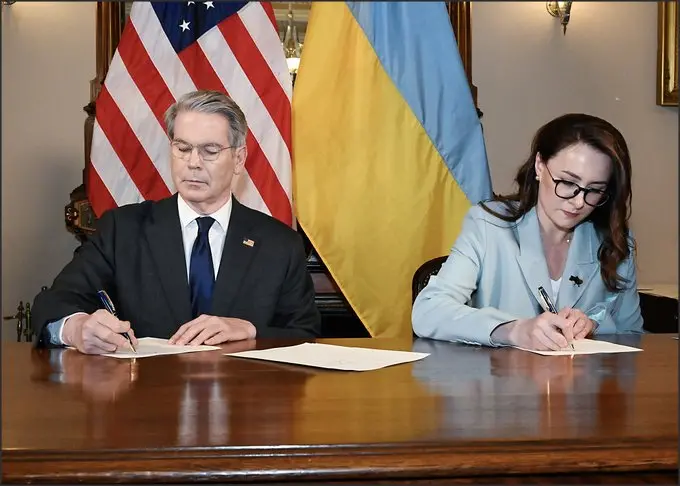After months of tense and sometimes bitter negotiations, the United States and Ukraine have officially signed a new “economic partnership agreement” that grants the U.S. access to Ukraine’s valuable rare earth minerals in exchange for creating a joint investment fund in the war-torn country.
The deal marks a turning point in bilateral relations and is seen as a cornerstone of Ukraine’s long-term reconstruction effort following Russia’s 2022 full-scale invasion. Here’s what you need to know about the deal, its context, and what it could mean moving forward.
What was signed?
On Wednesday, the U.S. Treasury Department announced that both countries had signed the long-awaited agreement. The deal establishes a joint investment fund between the U.S. and Ukraine to support Ukraine’s development and reconstruction, while granting the U.S. access to strategic mineral resources in Ukraine.
“As the President has said, the United States is committed to helping facilitate the end of this cruel and senseless war,” Treasury Secretary Scott Bessent said in a statement. “This agreement signals clearly to Russia that the Trump Administration is committed to a peace process centered on a free, sovereign, and prosperous Ukraine over the long term.”
He added, “And to be clear, no state or person who financed or supplied the Russian war machine will be allowed to benefit from the reconstruction of Ukraine.”
Ukraine’s Economy Minister Yulia Svyrydenko signed on behalf of the Ukrainian government in Washington.
What does Ukraine get?
According to Ukrainian officials, the agreement does not transfer ownership or control of natural resources. “All resources on our territory and in territorial waters belong to Ukraine,” Svyrydenko wrote on X (formerly Twitter) after the signing. “It is the Ukrainian state that determines what and where to extract. Subsoil remains under Ukrainian ownership — this is clearly established in the Agreement.”
Prime Minister Denys Shmyhal emphasized that this is “a strategic agreement on the establishment of an investment partnership fund.” He described it as “an equal and beneficial international agreement on joint investments in the development and recovery of Ukraine between the US and Ukrainian governments.”
He also clarified that “the American side may also count new, I emphasize new, military aid to Ukraine as a contribution to this fund.”
What was the hold-up?
Negotiations began shortly after U.S. President Donald Trump returned to the White House in January. The road to the signing was rocky. A last-minute disagreement over which documents would be signed nearly derailed the deal this week. Previously, Ukraine’s President Volodymyr Zelensky was expected to finalize the agreement during a visit to Washington in February, but the trip was abruptly cut short after a contentious Oval Office meeting.
One of the major sticking points was whether the U.S. would offer security guarantees as part of the deal. Trump initially resisted that, saying he wanted Ukraine to sign the agreement first and discuss guarantees later. Zelensky reportedly described the original draft as asking him to “sell” his country.
In the wake of the failed February trip, Trump suspended U.S. aid to Ukraine — though it has since been restored. The episode caused concern among Ukraine’s European allies, many of whom have since pledged to bolster their own support for Ukraine.
Trump has framed the final deal as Ukraine “paying back” for previous U.S. aid. Speaking to Fox News, Bessent said the agreement is “a signal to the American people, that we have a chance to participate, get some of the funding and the weapons, compensation for those.”
Shmyhal made clear, however, that the agreement “will not include assistance provided before its signing.”
Why are Ukraine’s minerals so important?
Ukraine is home to significant reserves of rare earth elements and critical raw materials. The U.S. Geological Survey lists 22 of its 50 critical materials as present in Ukraine, including those essential to electronics, clean energy technologies, and defense systems.
With China dominating the global supply of many of these resources, Western countries have been searching for alternatives — and Ukraine has emerged as a key potential partner.
A memorandum of understanding drafted under the Biden administration last year outlined plans to encourage U.S. companies to invest in Ukraine’s mining sector, contingent on Kyiv implementing transparent economic and environmental practices. Ukraine already has a similar agreement in place with the European Union, signed in 2021.
What comes next?
While the agreement has now been signed, implementation details remain unclear. The size of the investment fund and which projects will be prioritized have yet to be made public. However, with ownership terms clarified and new aid potentially contributing to the fund, both sides appear eager to use this deal as a platform for long-term collaboration — and as a message to Russia that Ukraine’s Western allies remain deeply invested in its future.
As Bessent put it: “This is not just about minerals — it’s about showing that Ukraine is not alone.”






